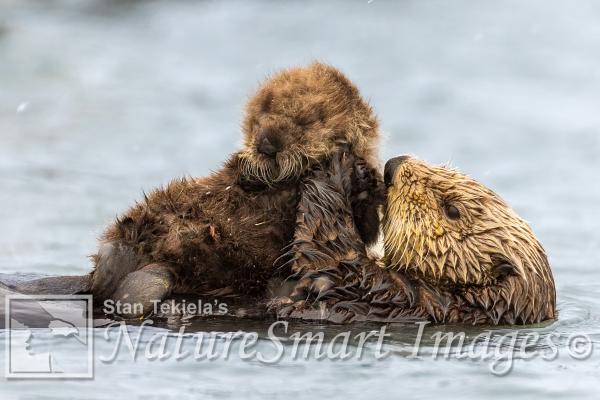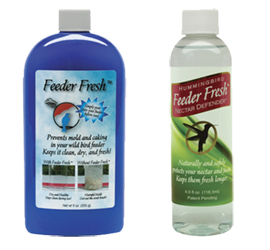View all of the titles in the
NatureSmart Bookstore

by Stan Tekiela
© NatureSmart
April 17, 2023
It is not often that I get to interact with two very similar but also very different species on back to back photo trips. I am talking about River Otters (Lontra canadensis) and Sea Otters (Enhydra lutris). Although they look remarkably similar, they are very different in so many ways. So, let’s take a look.
It all started while leading a photo workshop in Yellowstone National Park this winter. Along the frozen banks of the Yellowstone River, we located a family of River Otters consisting of an adult female and three young otters, which are called a pup or whelp. The adult male otters are called dogs and females a bitch (otter).
Over several days we found this family of otters swimming and hunting along the half-frozen river. River Otters never seem to stop moving. They are constantly running, playing, sliding in the snow, or swimming. Only when they pop up on the ice with a fish do they stop long enough to finish the meal but then they are off again.
Our North American River Otters are descendant from Old World River Otters. It is thought they crossed the Bering Land Bridge about 1.8 million years ago and have evolved into their own unique species. On average an adult male weighs about 25 to 30 pounds and females around 18 to 20 pounds. They are about 4 feet in length with the tail making up about one-third of that length. Their whiskers are long and thick and act to enhance their senses, especially while underwater. River Otters can live upwards of 10-15 years in the wild and up to 25 in captivity.
Watching and capturing images of these lively River Otters was one of the many highlights of this winter photo workshop. However, after three weeks in Yellowstone I flew directly to Alaska to spend a week photographing Sea Otters. Sea Otters look very similar only much, much larger than River Otters.
In order to capture images of Sea Otters we had charted a boat and spent 4 days bobbing up and down in the ocean searching for the otters. Adult male Sea Otters are absolutely huge, weighing in at 75 to 100 pounds. A few male otters have come in at 120 pounds. Females are smaller coming in at 40-75 pounds. They are nearly 5 feet long from nose to tip of tail. So, they are about the size of a small adult human.
Unlike most other marine mammals, the Sea Otter doesn’t have any blubber (excess fat) to stay warm but instead relies on an extremely thick coat of fur to keep warm and comfortable while in near freezing ocean water. Their fur is some of the densest of any animal. The fur consists of long, waterproof, guard hairs along with short underfur close to the skin. The combination of the two lengths of fur traps air and keeps the skin of the animal dry and limits any heat loss.
Sea Otters have many adaptations for a life in the ocean. Their nostrils and ears can close to aid in diving in deep water. Their hind feet are huge and webbed. They use their hind feet as their main source of propulsion. The position of their hind feet allows the Sea Otters to swim while on their back but makes walking on land very difficult. I only saw a couple of Sea Otters up and out of the water and when they were it was always right at the water’s edge.
One big difference between the River Otters and the Sea Otters is the tail. The Sea Otters tail is very short, thick, and slightly flattened. If you don’t look closely, you might think they don’t have a tail. The front legs are very short, and the paws have retractable claws. They use their front paws to hold food or their babies. The bones of the otter are denser than other animals’ bones, which helps to increase their density and helps to reduce their buoyancy and thus stay underwater with less effort while searching for food.
Sea Otters give birth year-round, and we were fortunate enough to find a female who had just given birth to a pup just moments before. The female held the newly born baby in her front paws and slowly turned the pup around and around while she licked him clean. Watching the caring nature of these huge otters was definitely a highlight of the trip. Being able to see and capture images of two different species of otter while on one trip was a fabulous opportunity and one that I won’t forget very soon. Until next time…
Stan Tekiela is an author / naturalist and wildlife photographer who travels the U.S. to study and capture images of wildlife. He can be followed on www.instagram.com, www.facebook.com and www.twitter.com. He can be contacted via his website at www.naturesmart.com.
The nationally syndicated NatureSmart Column appears in over 25 cities spanning 7 states: Minnesota, Wisconsin, Michigan, Illinois, Ohio, New York and Pennsylvania. It is a bi-weekly column circulated to over 750,000 readers.
Horned Lark
The overall population of ground nesting birds is steadily going down. Here in North America, we have hundreds of bird species who nest directly on the ground. Prairie birds such as Eastern and Western Meadowlarks are a good example. If you are older than 50 you most likely remember hearing...
Sharp-tailed Grouse
The rights of spring come in many different forms, shapes, colors, and patterns. But the end goal is always exactly the same—reproduction. In nature, everything can be boiled down to one of two things, finding food to survive and mating for reproduction. It’s as simple as...
Greater Prairie Chicken
I am not a stranger to getting up at O’ dark thirty, to be able to get out and capture some images of wildlife. Over the past 40 years I would say it is definitely in the hundreds if not thousands of times I’ve dragged myself out of bed so early. So, last week when the alarm went off...
Marsh Rabbit
For me, I enjoy all aspects of nature, not just birds. I find all of nature fascinating and that is what keeps me interested. So, while leading a photo tour to Florida recently I was so excited to see a crazy cool critter that isn’t what you expect when you see it. A true rule...
Each year, during June and July, Stan Tekiela offers two world-class wildlife photography tours. Here's your chance to learn some tricks of the trade from a top professional.
View all of the titles in the
NatureSmart Bookstore
Check out Stan's latest photos at
NatureSmart Wildlife Images
Do you have any interesting wildlife in your backyard? Any nesting birds, deer, turkeys, reptiles, amphibians, or other unique wildlife? Or maybe a fox or coyote den?
If so, contact Stan at stan@naturesmart.com with your backyard wildlife. If he can get a good photo of the subject, he will send you a print of the photo to hang on your wall.
Order Prints and posters of Stan's photos at
» Prints & Posters
Hear Stan on radio stations all across the Midwest.
» More Info

When he's out in the field, Stan relies on his Vortex Razor binoculars and Vortex Razor spotting scope to help find the subjects for his award winning wildlife photography.

For thirty years, professional wildlife photographer Stan Tekiela has counted on Hunt's Photo and Video to provide him with professional photography equipment.
From tripods to camera bodies and lenses, Hunt's has been Stan's place for everything that he needs. Personal service and prompt shipping means Stan can count on Hunt's to support his professional wildlife photography career.


Professional Wildlife Photographer Stan Tekiela always uses Feeder Fresh in his seed feeders to help keep the feeders and food dry, clean and mold free.
He also uses Feeder Fresh Nectar Defender in all of his hummingbird feeders. It safely keeps nectar fresh longer.